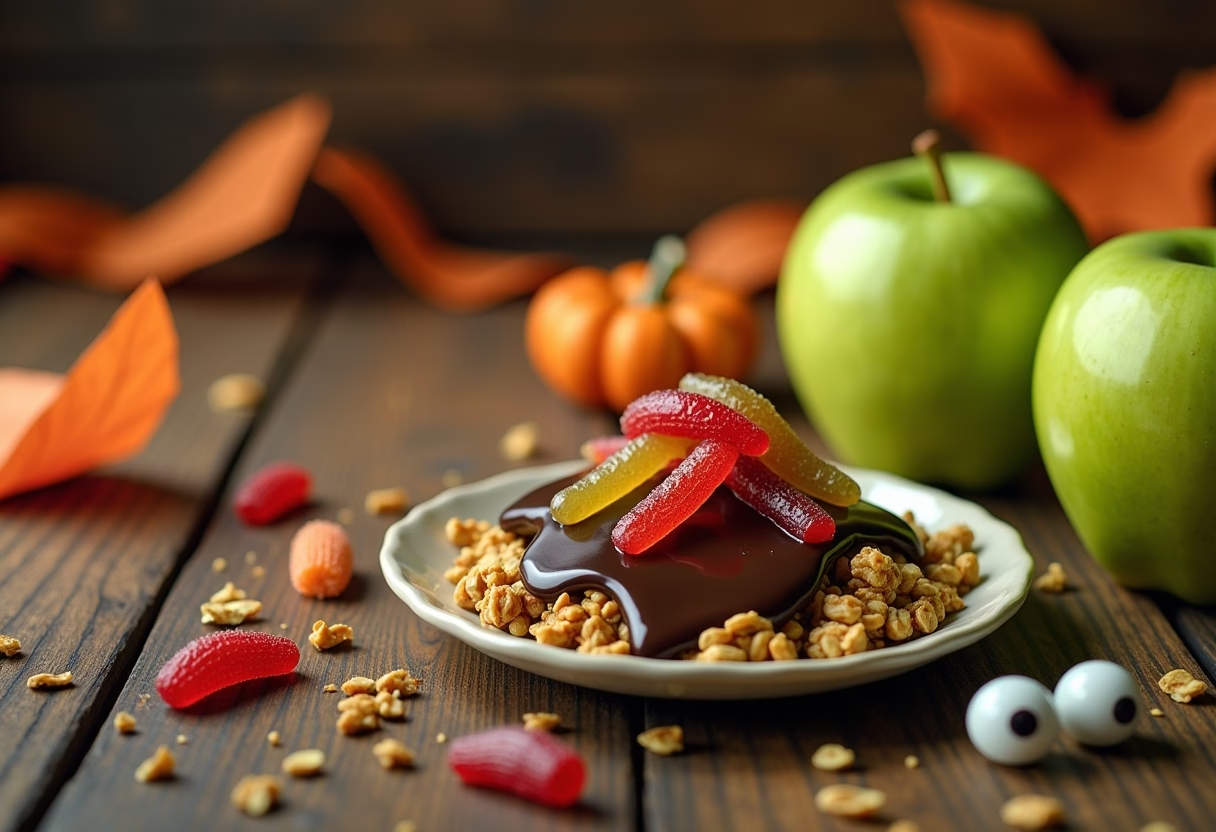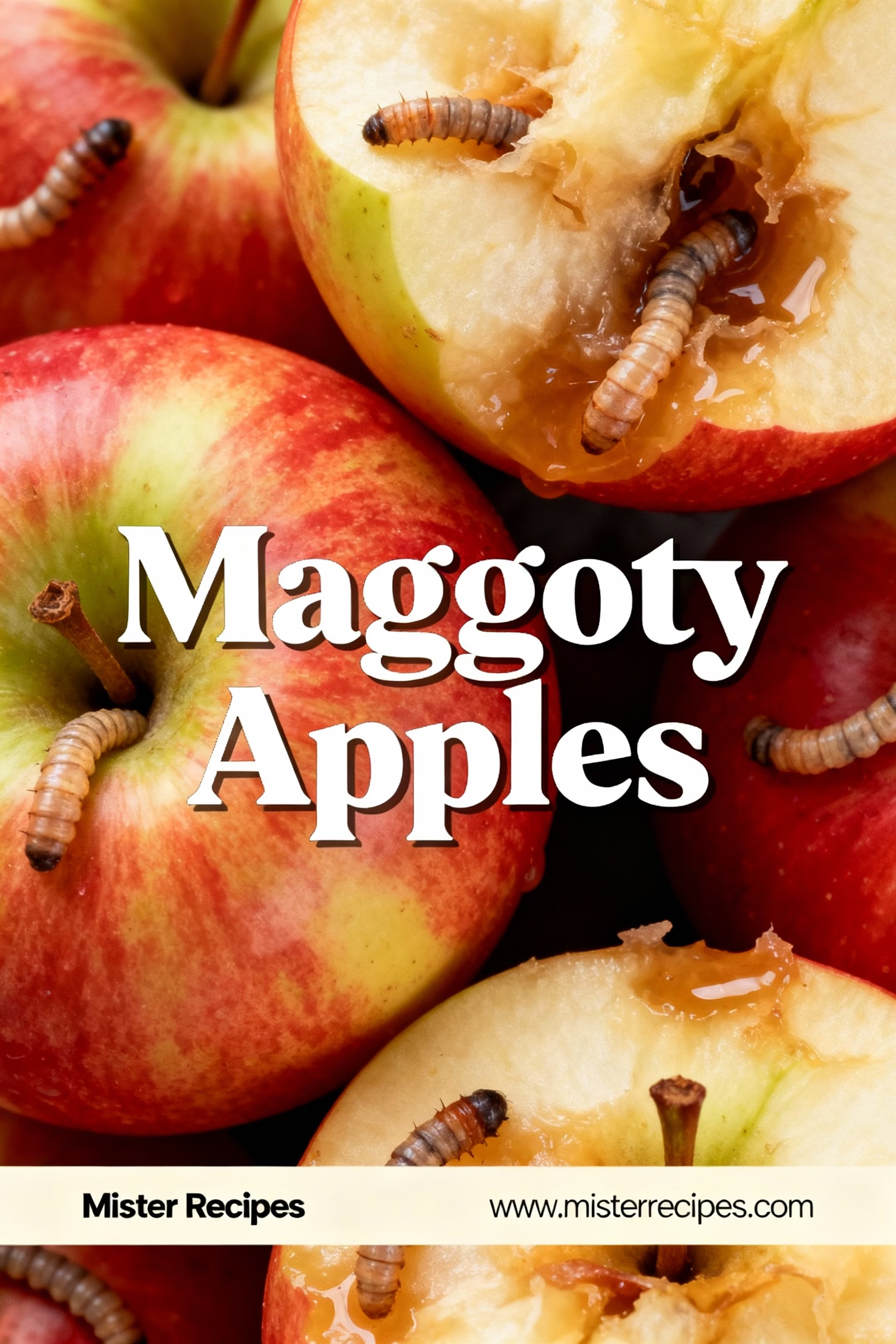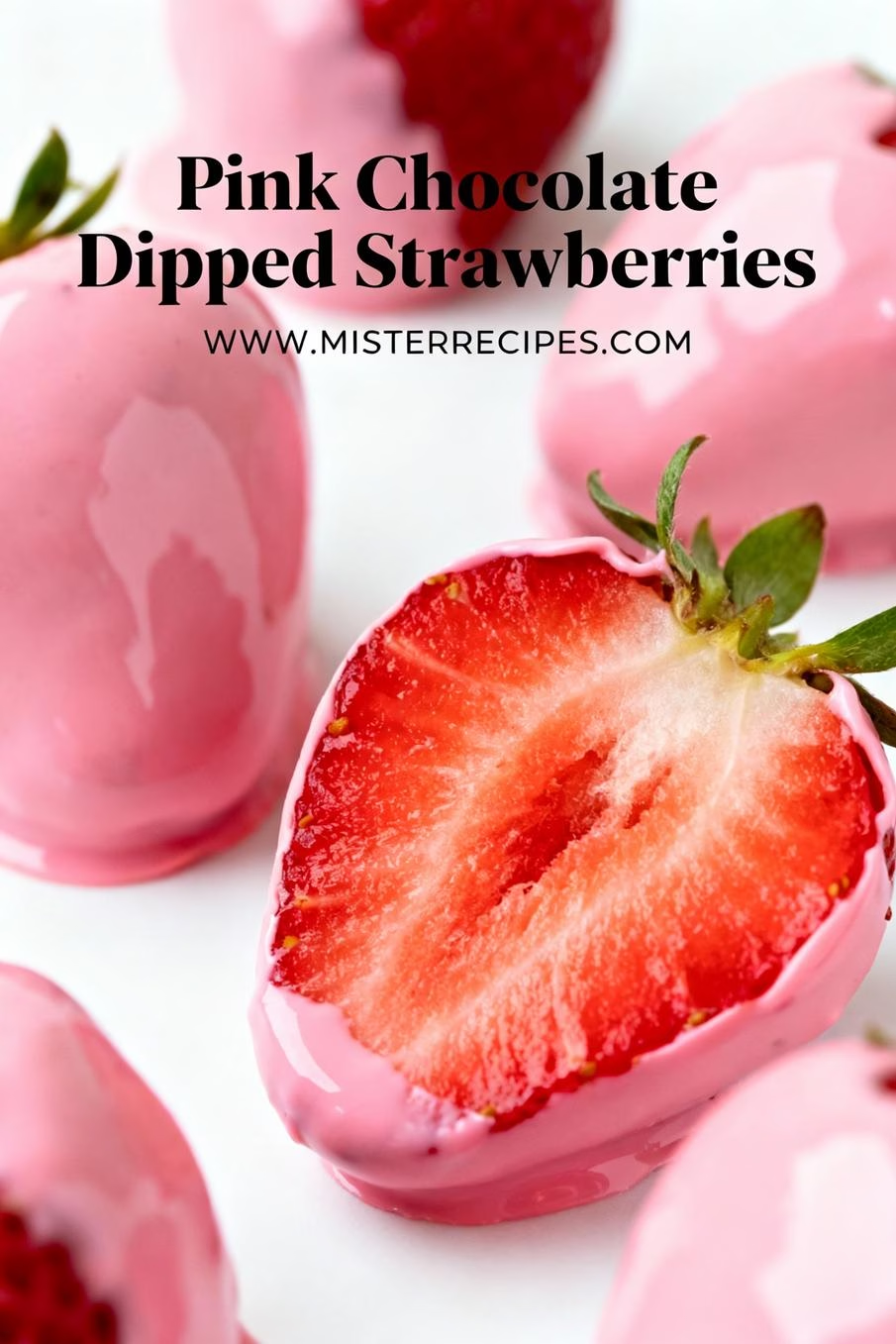Unveiling the Mystery of Maggoty Apples: A Gardener’s Guide to Prevention & Reclamation
Some mornings, before the frost lifts from the windowpanes, I find myself reminiscing about the apple tree in my grandmother’s backyard. It wasn’t the biggest, nor the most prolific, but oh, the joy of biting into a crisp, sweet apple, still warm from the sun. That memory is often tinged with another – the occasional, unpleasant surprise of a maggoty apple. It’s a moment that can make even the most seasoned home cook sigh with frustration, transforming a promise of a perfect pie into a discarded core. But what if I told you that those moments of disappointment, those discoveries of maggoty apples, don’t have to be a recurring nightmare in your orchard or even on your single backyard tree? What if reclaiming your harvest from these tiny, unwelcome guests was not only possible but wonderfully straightforward?
Here on MisterRecipes.com, we believe that every ingredient, every harvest, holds a story, and sometimes, that story includes a challenge. Today, we’re diving deep into the world of maggoty apples, not just to understand why they happen, but to empower you with the knowledge to prevent them and, yes, even how to manage the occasional rogue apple that slips through the cracks. For anyone who has lovingly tended an apple tree, only to find their precious fruit riddled with tunnels, this guide is for you. We’ll explore everything from identifying the early signs to implementing organic, eco-friendly strategies that work in harmony with nature, ensuring your apples are destined for delicious pies, crisps, and sauces, not the compost bin. It’s a journey from frustration to fruitful abundance, grounded in practical advice and a love for homegrown goodness.
My husband, Ethan, always says, “A good meal starts with good ingredients.” And for me, that often means ingredients nurtured right in our own garden. Living in Bend, Oregon, nestled amongst pine forests, we’ve learned a thing or two about working with nature’s rhythms. When it comes to apples, there’s nothing quite like the satisfaction of peeling a perfectly unblemished fruit that you’ve grown yourself. This isn’t just about avoiding the unpleasant surprise; it’s about preserving the integrity of your harvest, ensuring every bite is as delicious and wholesome as nature intended. So, let’s roll up our sleeves and transform those “what ifs” into “we can!”, making maggoty apples a thing of the past.
We’re going beyond just identifying the problem; we’re offering solutions – sustainable, thoughtful solutions that honor both your efforts and the environment. Because a perfectly cultivated apple isn’t just food; it’s a testament to patience, care, and a connection to the earth.
Why You’ll Love This Guide to **Maggoty Apples**
There’s a special kind of heartache that comes with biting into a crisp apple, only to find a tiny tunnels within – the tell-tale sign of maggoty apples. It’s not just about losing a piece of fruit; it’s about the effort, the anticipation, the promise of a homemade apple crisp or a warm batch of baked apples that suddenly feels out of reach. But what if that feeling of disappointment could be replaced with empowerment, with knowledge, and with a harvest that rivals your sweetest dreams?
You’ll love this guide because it turns the challenge of maggoty apples into an actionable plan. Here at MisterRecipes, we believe in mindful cooking and mindful gardening, and that means understanding our ingredients from orchard to oven. This isn’t just about complex scientific jargon; it’s about real-world, applicable strategies presented with the warmth of a good friend sharing their hard-won wisdom.
Here are just a few reasons why this guide will become your go-to resource for a worm-free apple harvest:
- Empowerment Through Knowledge: We demystify the culprits behind maggoty apples, from the elusive apple maggot to the sneaky codling moth infestation in apples, so you know exactly what you’re up against. Understanding is the first step to successful prevention.
- Practical, Easy-to-Follow Strategies: Forget complicated sprays and confusing schedules. We break down prevention and treatment into simple, actionable steps that even a beginner gardener can implement with confidence. Think of it as a recipe for a perfect apple harvest!
- Focus on Organic & Eco-Friendly Solutions: Our philosophy centers on working with nature, not against it. We highlight organic methods for controlling maggoty apples and eco-friendly solutions for maggoty apples, ensuring your garden remains a healthy, vibrant ecosystem for your family and local wildlife.
- Holistic Approach to Prevention: This isn’t a band-aid solution. We cover everything from how to prevent maggoty apples before they strike, to treating maggoty apples in the garden if they do appear, and even identifying signs of maggoty apples early on. It’s a comprehensive plan for lasting success.
- Harvesting More Usable Fruit: Ultimately, this guide helps you bring more beautiful, wholesome apples into your kitchen, ready to be transformed into cherished family recipes. Less waste, more deliciousness – that’s a win in my book!
This isn’t about perfectly manicured orchards – it’s about making your backyard apple tree, big or small, a source of joy and delicious fruit, free from the unwelcome surprise of worms in apples. It’s about taking control, understanding the rhythms of nature, and enjoying the sweet reward of your labor, bite by unblemished bite. We’re here to help you cultivate not just apples, but confidence and connection to your food source.
Ingredients for Maggoty Apples (Prevention & Treatment)
When tackling the challenge of maggoty apples, the “ingredients” aren’t for eating, but for ensuring a healthy, robust harvest! Think of these as your toolkit for cultivating unblemished fruit and creating a garden environment unsuitable for pests.
Here’s what you might need, depending on your chosen prevention and treatment methods:
- Apple Maggot Traps (Red Sphere or Yellow Sticky Traps): These mimic ripe apples or foliage, attracting and trapping adult apple fruit pests like the apple maggot.
- Kaolin Clay (Surround WP): A fine, white clay that forms a protective barrier on fruit, deterring codling moth infestation in apples and apple maggots from laying eggs.
- Insect Netting or Row Covers: A physical barrier to keep adult insects away from developing fruit.
- Beneficial Nematodes: Microscopic worms that are natural predators of various soil-dwelling pests, including some stages of apple fruit pests.
- Compost or Well-rotted Manure: To maintain healthy soil, which contributes to strong, resilient trees.
- Pruning Shears/Loppers: For proper tree maintenance and air circulation, reducing pest harborage.
- Horticultural Oil (Neem Oil): An organic spray that can smother eggs and young larvae of pests like fruit fly damage on apples and worms in apples.
- Apple Cider Vinegar + Molasses (for homemade traps): A simple homemade remedy for maggoty apples to attract fruit flies.
Substitutions & Considerations:
- For Commercial Traps: If specific commercial traps aren’t available, homemade traps (like a red ball coated with Tanglefoot) can be effective.
- For Organic Sprays: While Neem oil is a great multi-purpose option, other organic insecticides approved for fruit trees might be available in your area. Always check local regulations and product labels.
- Integrated Pest Management (IPM) for maggoty apples is key: Don’t rely on just one method! A combination of cultural practices, monitoring, and targeted treatments is most effective.
Remember, the goal is to create an environment where these pests can’t thrive, rather than solely reacting once maggoty apples appear. This proactive approach ensures healthier trees and a more abundant, unblemished harvest.

How to Make Maggoty Apples (NOT! How to Prevent Them!)
Ah, the title makes me chuckle a bit, doesn’t it? Because crafting maggoty apples is precisely what we’re trying to avoid! Instead, let’s look at this section as “How to Prevent Maggoty Apples” – a step-by-step guide to nurturing a harvest free of those unwelcome surprises. Imagine this as your gentle, guiding hand through the growing season, a dance between careful observation and timely action. Each step is designed to bring you closer to that perfect, unblemished fruit, ready for the most delightful apple cider donut muffins or a classic apple pie.
Step-by-Step Instructions to Prevent Maggoty Apples
Let’s walk through this together, just like we’d approach a new recipe, methodically and with a little love.
- Understand Your Adversaries (Early Spring): Before the first blossom opens, it’s vital to know who you’re up against. The primary culprits for maggoty apples are the apple maggot (a small fly) and the codling moth infestation in apples. They have different life cycles, so understanding them helps pinpoint your actions. Adult apple fruit pests like the apple maggot fly emerge from the soil in early summer, while codling moths emerge earlier.
- Sanitation is Key (Year-Round): This is perhaps the most fundamental step.
- Fall & Winter: Rake up and dispose of any fallen apples, especially those showing signs of worms in apples, from the previous season. Many pests overwinter in fallen fruit or in the soil beneath the trees. If you have chickens, they can be wonderful assistants for this!
- Spring & Summer: Continue to promptly pick up and destroy (not compost, to prevent reinfection) any windfalls or visibly maggoty apples throughout the growing season. This disrupts the pest life cycle by removing larvae before they can return to the soil to pupate.
- Monitor with Traps (Late Spring to Early Summer): This is your early warning system.
- Apple Maggot Traps: Hang red sphere traps (which mimic ripe apples) or yellow sticky traps in your apple trees in late May to early June, before flies begin laying eggs. Place them strategically, about eye-level, on the sunny side of the tree. Check them frequently to see if any adult apple maggot flies have been caught. This helps you gauge pest pressure and the best time for further intervention. If you’re a DIY enthusiast, a red ball coated with Tanglefoot also works!
- Codling Moth Traps: Pheromone traps specifically designed for codling moths can be hung around bloom time. These attract male moths, helping you monitor their presence.
- Consider Physical Barriers (Early Fruit Development):
- Bagging: As fruit sets and reaches about 1 inch in diameter, you can individually bag apples using small paper bags (like lunch bags) or specialized fruit protection bags. This creates a physical barrier against both apple maggot and codling moth infestation in apples. It’s a labor of love for smaller trees but incredibly effective.
- Insect Netting: For younger or smaller trees, covering the entire tree with fine insect netting once the fruit has set can completely exclude pests. Just make sure it’s secured around the trunk.
- Utilize Organic Sprays (Targeted & Timely): If monitoring shows high pest pressure, organic methods for controlling maggoty apples can be employed.
- Kaolin Clay (Surround WP): Apply a fine spray of kaolin clay to cover your apples (and leaves) once they reach pea-size. This forms a chalky white barrier that deters egg-laying by both apple maggots and codling moths. Reapply after heavy rains. It’s an effective eco-friendly solution for maggoty apples.
- Neem Oil: Horticultural oil, like neem oil, can be sprayed before bud break to target overwintering eggs, or during the growing season as a repellent and to disrupt pest feeding and reproduction. Always follow label instructions carefully.
- Beneficial Insects (Year-Round): Encourage natural predators! Planting diverse flowers and herbs around your orchard attracts beneficial insects like parasitic wasps, lacewings, and predatory mites, which can prey on apple fruit pests. This is a cornerstone of Integrated Pest Management (IPM) for maggoty apples.
- Proper Pruning & Tree Health (Dormant Season & Growing Season): A healthy tree is a resilient tree.
- Dormant Pruning: During late winter or early spring, prune your trees to ensure good air circulation and sunlight penetration. This reduces humid, shaded areas where some pests thrive and helps ripen fruit evenly. Removing dead or diseased branches also eliminates potential pest habitats.
- Watering & Feeding: Ensure your apple tree receives adequate water, especially during dry spells, and appropriate nutrition. A strong, unstressed tree is better able to withstand pest attacks.
Each of these steps, when woven together, creates a robust defense against maggoty apples. It’s a journey of attentive gardening, turning potential disappointment into the sweet success of a healthy, delicious harvest.
Pro Tips & Variations
Cultivating beautiful, unblemished apples, free from the woes of maggoty apples, is an art honed over seasons. Just like a cherished family recipe, there are always little tweaks and insights that elevate the outcome. Here are some pro tips and variations to help you on your journey, adding layers of wisdom to your battle against apple maggot and codling moth infestation in apples.
- Patience is a Virtue (and a Strategy): When it comes to how to prevent maggoty apples, don’t expect instant results with organic methods. It’s about building a healthy ecosystem and disrupting pest cycles over time. Consistency, year after year, will dramatically reduce pest pressure. Think of it as a long-term investment in your harvest!
- The Power of Timely Intervention: Timing is everything in pest management. For apple maggots, applying controls before the adult flies lay eggs is crucial. For codling moths, understanding their emergence patterns through pheromone traps helps you target your sprays (like kaolin clay or organic insecticides) when they’re most vulnerable. A few days can make all the difference.
- “Trap and Trick” with Decoy Trees: If you have an abundance of apple varieties, consider designating a “decoy” tree (perhaps an older, less productive one, or a crabapple) where you can concentrate your trapping efforts with red sphere traps. This can draw pests away from your prime eating apples. It’s a clever trick drawn from biological control of apple maggots.
- Consider “Trunk Banding” for Codling Moths: For codling moth infestation in apples, a simple trick is to wrap a strip of corrugated cardboard (4-6 inches wide) tightly around the tree trunk in early summer. Moths will pupate within this cardboard. In late fall, remove and destroy the band to eliminate overwintering pupae. It’s an easy, eco-friendly solution for maggoty apples.
- Embrace Diversity: Companion planting isn’t just for aesthetics! Strong-smelling herbs like mint, chives, and dill planted around your apple trees can confuse and deter pests by masking the scent of the apple tree. This contributes to Integrated Pest Management (IPM) for maggoty apples by creating an environment less hospitable to apple fruit pests.
Variations in Approach:
- “No-Spray” Philosophy: For those committed to a truly hands-off approach, emphasizing sanitation (picking up fallen fruit rigorously), bagging individual apples, and encouraging natural predators can still yield a decent harvest, especially on smaller trees or in areas with lower pest pressure. This often aligns with those seeking homemade remedies for maggoty apples and preventing maggoty apples in organic orchards.
- Micro-Orchard Focus: If you only have one or two apple trees, bagging each fruit is a highly effective, albeit time-consuming, method that guarantees unblemished apples without any sprays. It’s a labor of love that ensures precious fruit is protected from worms in apples.
- Community Collaboration: If your neighbors also have apple trees with maggoty apples, consider a neighborhood-wide approach to sanitation and trapping. Pests don’t respect property lines, and a cooperative effort can dramatically reduce overall pest populations in your area.
Remember, every garden is unique, and learning what works best for your trees and your specific conditions is part of the joy and challenge of growing.
Serving Suggestions (for Your UN-Maggoty Apples!)
After all that careful tending, monitoring, and proactive prevention to keep those pesky maggoty apples at bay, you’re finally rewarded with a bounty of beautiful, unblemished fruit! This is the moment we’ve been working towards – the sweet, crisp payoff ready for your culinary creativity. While the journey to prevent worms in apples might be challenging, the serving possibilities for your perfect fruit are endless and joyfully simple.
Here at MisterRecipes, we believe in celebrating the harvest. Here are some of my favorite ways to enjoy those hard-won, perfectly fresh apples, free from the worry of apple maggot or codling moth infestation in apples:
- Simply Sliced and Served: Sometimes, the best way to appreciate a pristine apple is in its purest form. A bowl of freshly sliced apples, perhaps with a sprinkle of cinnamon or a drizzle of local honey, makes for a perfect snack. It truly lets the natural sweetness and crisp texture shine, a testament to your successful organic methods for controlling maggoty apples.
- Classic Apple Pie or Crisp: Is there truly anything more comforting than a warm, bubbling apple pie or a rustic apple crisp? Peeling and slicing your own un-maggoty apples for these timeless desserts is profoundly satisfying. Use a blend of sweet and tart varieties for the most complex flavor. Pair with a scoop of vanilla bean ice cream for pure bliss. You might love Easy Apple Cider Donut Muffins or Sheet Pan Apple Cinnamon Roll Bites with your successful harvest!
- Homemade Applesauce or Apple Butter: For a taste of autumn throughout the year, transform your abundance of flawless apples into batches of homemade applesauce or rich apple butter. These are wonderful ways to preserve the intense apple flavor and are fantastic for topping pancakes, swirling into oatmeal, or simply enjoying by the spoonful. This is often my go-to for slightly less-than-perfect, but certainly not maggoty, apples.
- Savory Pairings: Don’t limit apples to just sweet! Sautéed apple slices make a fantastic accompaniment to roasted pork or chicken. Their sweetness beautifully contrasts with savory meats. I often add them to stuffings or even a winter salad with walnuts and blue cheese. It’s a delicious way to showcase the versatility of your successful harvest. Fried Apple Pies are also a delightful savory-sweet treat.
- Autumnal Salads: Diced apples add a delightful crunch and touch of sweetness to fall salads. Combine them with mixed greens, toasted pecans, crumbled goat cheese, and a light vinaigrette for a refreshing and hearty dish. The crispness of an un-maggoty apple elevates the entire salad.
Each of these suggestions celebrates the simple joy of eating fruit that you’ve nurtured and protected. It’s a reminder that a little effort in the garden leads to abundant flavor in the kitchen, turning the challenge of fruit fly damage on apples into a triumph of taste.
Storage & Reheating (for Your Apple Creations)
Once you’ve successfully sidestepped the challenge of maggoty apples and transformed your gorgeous harvest into delicious dishes, knowing how to properly store and, if necessary, reheat them is the next crucial step. We never want a single bit of that hard-won, unblemished apple goodness to go to waste! Whether it’s a whole apple or a freshly baked pie, thoughtful storage extends its life and flavor.
Storing Fresh, Un-Maggoty Apples:
- Countertop (Short-Term): If you plan to eat your apples within a few days, they can be stored on the countertop at room temperature, away from direct sunlight. This is ideal for quick snacking.
- Refrigerator (Long-Term): For longer storage, up to several weeks or even months, place your clean, dry apples in a plastic bag with a few small holes for ventilation, or in the crisper drawer of your refrigerator. The cool, humid environment keeps them crisp and fresh, perfectly preserving the fruit you protected from worms in apples. Avoid storing them near strong-smelling foods, as apples can absorb odors.
- Ethylene Gas: Apples produce ethylene gas, which can ripen other fruits and vegetables prematurely. Store them separately from produce that is sensitive to ethylene, like leafy greens or bananas.
Storing & Reheating Baked Apple Dishes (e.g., Pies, Crisps, Sauces):
- Baked Goods (Pies, Crisps):
- Countertop (Short-Term): A freshly baked apple pie or crisp can stay at room temperature for up to 2 days, especially if it’s got a crumb topping or is covered.
- Refrigerator (Mid-Term): For longer storage, cover tightly with plastic wrap or foil and refrigerate for up to 3-5 days. This is especially true for anything with dairy or eggs.
- Freezer (Long-Term): Most apple pies and crisps freeze beautifully! Allow them to cool completely, then wrap tightly in plastic wrap and then foil. Freeze for up to 3 months. For best results, freeze whole pies before baking, then bake from frozen, adding an extra 20-30 minutes to the baking time.
- Reheating (Pies/Crisps):
- From Refrigerated: For pies and crisps, a gentle warm-up in a preheated oven (300-350°F or 150-175°C) for 15-20 minutes will bring back their warmth and flaky texture.
- From Frozen: If baking from frozen, follow specific recipe instructions. Otherwise, thaw overnight in the refrigerator, then reheat as above.
- Applesauce/Apple Butter:
- Refrigerator: Store in airtight containers in the refrigerator for up to 1-2 weeks.
- Freezer: For longer preservation, applesauce and apple butter freeze exceptionally well. Portion into freezer-safe containers or bags, leaving headspace. Freeze for up to 6 months.
- Reheating: Thaw in the refrigerator overnight or gently reheat on the stovetop over low heat, stirring occasionally.
Proper storage is the final step in ensuring that your efforts to prevent maggoty apples translate into delicious, lasting enjoyment. So, don’t let a single apple go unappreciated!
FAQ about **Maggoty Apples**
It’s natural to have questions when you’re trying to protect your precious apple harvest from pests. The fear of biting into a maggoty apple can linger, but with a little information, you can arm yourself with confidence. Here are some common questions I hear from fellow home gardeners and cooks about maggoty apples and their prevention.
Q1: What exactly causes **maggoty apples**? Are there different culprits?
A1: Yes, there are a couple of main culprits for maggoty apples! The most common offenders are the apple maggot (a small fly) and the codling moth infestation in apples.
- Apple Maggot: The adult fly lays eggs just under the skin of the developing apple. The larvae (maggots) then tunnel throughout the flesh, leaving brown trails and eventually causing the fruit to rot and drop prematurely.
- Codling Moth: This moth lays eggs on the leaves and fruit surface. When the larvae hatch, they bore into the fruit, usually near the calyx (the bottom end of the apple), and tunnel to the core, often feeding on the seeds. Their exit holes are usually visible, often filled with frass (insect excrement). Both cause worms in apples, but their entry points and tunneling patterns can differ. Fruit fly damage on apples can also occur, though often less severe than these two.
Q2: Can I still eat an apple if it has a small maggot?
A2: While technically not harmful to humans if ingested, finding a maggot in an apple is, understandably, unappetizing. Most people choose to discard any apple with worms in apples. If the damage is very minor and isolated, some might cut out the affected area, but it’s generally recommended to avoid eating heavily infested fruit. The best practice is to focus on how to prevent maggoty apples in the first place to ensure a wholesome harvest. There’s nothing quite like a pristine, unblemished apple!
Q3: What’s the best organic way to prevent **maggoty apples**?
A3: A multi-pronged organic method for controlling maggoty apples is most effective.
- Sanitation: Consistently removing and destroying fallen maggoty apples is paramount.
- Trapping: Red sphere traps for apple maggots and pheromone traps for codling moths are excellent monitoring and control tools.
- Barriers: Bagging individual fruit or using insect netting provides a physical barrier.
- Kaolin Clay: Applying kaolin clay (e.g., Surround WP) to fruit creates a protective, deterrent layer.
- Beneficial Insects: Encouraging natural predators is part of Integrated Pest Management (IPM) for maggoty apples.
There isn’t one single “best” method; rather, it’s a combination of these eco-friendly solutions for maggoty apples that yields the best results.
Q4: My apples already have **maggoty apples**. What should I do now?
A4: If you’re already seeing maggoty apples, focus on containment and future prevention.
- Immediate Action: Pick off and destroy all affected fruit as soon as you spot it. Do not compost it, as the larvae can complete their life cycle there. Bag them and dispose of them in the trash. This is crucial for treating maggoty apples in the garden.
- Monitor: Step up your use of traps to assess the pest pressure.
- Next Season: Implement a more robust prevention plan for the following year, focusing on early intervention and methods like kaolin clay or rigorous bagging to break the pest cycle. This includes understanding best practices for managing maggoty apples proactively.
Q5: How do I know if I have **apple maggot** or **codling moth infestation in apples**?
A5: Here’s how to distinguish them by identifying signs of maggoty apples:
- Apple Maggot: You’ll typically see small, pin-prick-sized entry holes on the apple skin, sometimes with a sunken spot around them. Internally, the tunnels are winding and often discolored (brown). The fruit often ripens prematurely, becomes soft, and drops early.
- Codling Moth: The entry hole is usually larger and more obvious, often near the calyx (bottom) or stem end, and may have brown frass (looks like sawdust) protruding from it. The tunnel typically goes straight to the core, where the larva feeds on the seeds.
Knowing the difference helps you select the most targeted prevention strategies for your specific pest problem.
Final Thoughts on **Maggoty Apples**
The journey of growing your own food, of nurturing an apple tree from blossom to fruit, is one of the most rewarding experiences a home gardener can embark on. But let’s be honest, that journey isn’t without its bumps, its challenges, and its occasional disappointments – like the unwelcome discovery of maggoty apples. It can feel like a betrayal from nature, a spoil of all your careful tending.
Yet, here at MisterRecipes, we believe that every challenge in the kitchen or garden is an opportunity to learn, to grow, and to connect more deeply with the food we eat. This comprehensive guide, meticulously crafted to help you understand and combat maggoty apples, is more than just about pest control; it’s about reclaiming your harvest, one beautiful, unblemished apple at a time. It’s about empowering you to turn frustration into fruitful abundance, transforming the problem of worms in apples into the triumph of a perfect pie.
It’s a testament to patience, to observation, and to working in harmony with the natural world around us. From understanding the lifecycle of the mischievous apple maggot to implementing clever organic methods for controlling maggoty apples, we’ve covered the ground that will help your apple trees thrive. Remember, whether it’s through diligent sanitation, strategic trapping, or thoughtful use of eco-friendly solutions for maggoty apples, every step you take brings you closer to that dream of a perfect harvest.
Think of those sweet, crisp bites of apple that await you –
bites free from the unexpected Guest, destined for the most delicious crumbles, sauces, and snacks. That’s the real reward. That’s the heart of why we put so much care into our gardens and our kitchens. Because, as I always say, “I don’t chase perfection in food – I chase connection.” And preventing maggoty apples helps us connect more purely with the earth’s bounty.
So, go forth with confidence, dear friend. May your baskets be full, your apples be pristine, and your kitchen be filled with the joyous scent of homegrown goodness. Don’t forget to save this guide on Pinterest, leave a comment with your own experiences, and subscribe to MisterRecipes.com for more stories from the skillet and solutions from the garden! Let’s cultivate a wonderful harvest, together.

Preventing Maggoty Apples: A Gardener’s Guide
Ingredients
Equipment
Method
- Understand Your Adversaries (Early Spring): Learn about apple maggot flies and codling moths, their life cycles, and when they emerge to plan your prevention strategy.
- Sanitation is Key (Year-Round): In fall and winter, rake up and dispose of fallen apples, especially those showing signs of worms. In spring and summer, promptly pick up and destroy any windfalls or visibly maggoty apples to disrupt the pest life cycle.
- Monitor with Traps (Late Spring to Early Summer): Hang red sphere traps or yellow sticky traps in your apple trees in late May to early June. Place them strategically, about eye-level, on the sunny side of the tree. Check them frequently. Pheromone traps for codling moths can be hung around bloom time.
- Consider Physical Barriers (Early Fruit Development): As fruit sets and reaches about 1 inch in diameter, individually bag apples using small paper bags or specialized fruit protection bags. For younger trees, cover the entire tree with fine insect netting once the fruit has set, securing it around the trunk.
- Utilize Organic Sprays (Targeted & Timely): If monitoring shows high pest pressure, apply kaolin clay to cover apples and leaves once they reach pea-size, forming a deterrent barrier. Reapply after heavy rains. Use horticultural oil like neem oil before bud break or during the growing season as a repellent and to disrupt pest feeding.
- Beneficial Insects (Year-Round): Encourage natural predators by planting diverse flowers and herbs around your orchard to attract beneficial insects like parasitic wasps, lacewings, and predatory mites.
- Proper Pruning & Tree Health (Dormant Season & Growing Season): During late winter or early spring, prune trees for good air circulation and sunlight penetration. Remove dead or diseased branches. Ensure your apple tree receives adequate water, especially during dry spells, and appropriate nutrition.



